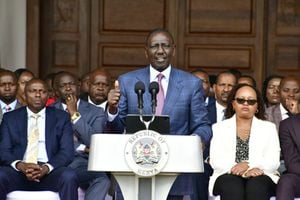Prime
NSSF pays out Shs360b in benefits

NSSF has been pushing its regional reach by investing in office space in different locations with the most recent being Jinja Town. FILE PHOTO
What you need to know:
Increased revenues. Beyond paying out members benefits, NSSF recorded Shs1.6 trillion in revenue, up from Shs912b posted last year.
National Social Security Fund (NSSF) paid out Shs360b as benefits to members in the 2017/18 financial year, a 29 per cent increase from the Shs278b paid out in the same period last year.
This is an indication of an improved payout system that has seen contributors give the Fund positive response in the last five years.
This was revealed during a media roundtable where the Fund released its performance for the 2017/18 financial year.
NSSF, according to results released yesterday, for the first time hit Shs1.6 trillion in revenue up from Shs912b posted last year.
This was mainly attributed to growth in interest income and regional equity markets.
“This was largely driven by the strong recovery of the equity market mostly in Uganda and Kenya and the foreign currency gains because of the depreciating Ugandan shilling, but also the interest we earned from our fixed income investments,” Mr Richard Byarugaba, the NSSF managing director, said.
In Uganda, NSSF has its investments in Umeme, Housing Finance Bank, Uganda Clays Limited and Serena Hotel.
Because of the big movement in revenue, total assets under management grew 26 per cent to hit Shs9.98 trillion from Shs7.92 trillion the previous financial year.
Investments
The Fund’s assets are mainly invested in fixed income investments, private equity and real estate.
The fund ended the year with its fixed income assets at 75 per cent, equity at 18.09 per cent and real estate at 6.53 per cent.
This was from 77 per cent, 16 per cent and 7 per cent, respectively the previous year.
According to Mr Byarugaba, in regard to the Fund’s strategic asset allocation, it was able to reduce its exposure to fixed income because interest rates were coming down whereas it increased its exposure to equity because the stock markets were doing well.
Exposure to real estate was slightly down because the Fund does not want to have a lot of properties on the market when demand is insufficient.
NSSF’s desired target is to have 70 per cent of its assets allocated to fixed income assets, 25 per cent to businesses (equity) and 5 per cent to real estate. Now with 2.2 million members, contributions recorded a 14 per cent growth to Shs1.05 trillion for the financial year 2017/18 compared to Shs917b the previous financial year.
Most of this was a result of improved compliance levels which for three months increased to 81 per cent.
The Fund also saw a rise in new members from small and medium enterprises and voluntary contributions.
The Fund will pay members an interest rate of 2 per cent above the 10 year inflation which stands at 7.3 per cent.
“We hope that the return that the minister will announce on August 28 during the annual members meeting will be 2 percentage points above the 7.3 per cent. At least we guarantee that we will give you 9.3 per cent,” Mr Byarugaba said.
REQUIRED DISCIPLINE
According to Mr Richard Byarugaba, the Fund has not only grown more efficient in the way it does business, it has maintained the required discipline to ensure high levels of productivity at the lowest cost possible. “This is a commitment we made and we will continue to focus on creating value for our members at a low cost,” he says.
The growth, he said, has been boosted by a rebound in economic growth that currently stood at 5.8 per cent in the 2017/18 financial year down from 3.9 per cent the previous year.




